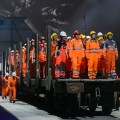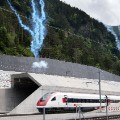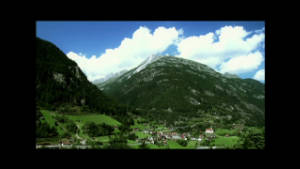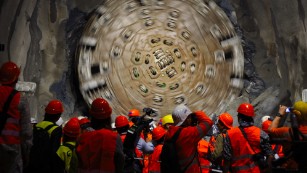Seventeen years after construction crews started boring beneath the Swiss Alps, the world's longest, deepest tunnel officially opened Wednesday.
Fittingly for a project billed as Switzerland's "construction of the century," the Gotthard Base Tunnel was inaugurated amid colorful, sometimes surreal scenes, with visiting dignitaries treated to costumed dancers, fireworks and plenty of yodeling and alphorns.
European leaders including German Chancellor Angela Merkel, French President Francois Hollande and Italian Prime Minister Matteo Renzi joined Swiss President Johann Schneider-Ammann on the first official journey on the line.
The 57-kilometer long (35-mile long) tunnel creates a high-speed rail link deep beneath the famous mountain range, connecting northern and southern Europe.
And with characteristic Swiss punctuality, this major engineering feat has been completed on schedule.
Shortcut through the Alps
Reaching a depth of 2,300 meters (7,545 feet, almost 1.5 miles) the tunnel will slice an hour off the travel time between Zurich, Switzerland, and Milan, Italy.
Trains will travel the tunnel, which runs between the towns of Erstfeld in the north and Bodio in the south, in only 20 minutes, reaching speeds of up to 250 kilometers an hour (155 mph), according to the Swiss Travel System.
Beyond the anticipated benefits for travel and trade, the project will provide a direct and economic route for freight transport.
AlpTransit Gotthard, the company behind the construction of the tunnel, says the project will boost the efficiency and reliability of rail freight, making it more competitive.
Gotthard overtakes the 53.9-kilometer Seikan Tunnel in northern Japan as the longest rail tunnel in the world, relegating the 50.5-kilometer Channel Tunnel between Britain and France into third place.
Environmental benefits
The line, which will begin full operations in December, will establish a mainline rail corridor through Europe from the Dutch port of Rotterdam in the north to the Italian port of Genoa on the Mediterranean.
It is expected to bring significant environmental benefits by diverting freight sent by road on to rail instead.
"The main reason for the construction of this tunnel was to get the goods traffic off the motorway and onto the trains," Simon Peggs of AlpTransit Gotthard, told CNN when the tunnel was completed.
"It's just getting more and more (busy) every year and it was estimated that by 2020, the roads will be so blocked that something had to be done."
It is anticipated the economic benefits of increased trade and travel efficiency will make inroads into the tunnel's $12 billion construction cost.
Alpine route remains
The new tunnel, greenlighted by the Swiss public in a national referendum in 1992, bypasses the scenic original Gotthard line.
That line, popular with tourists for its panoramic views as it winds through the mountain range, crossing 205 bridges in the process, will continue to operate, the Swiss Travel System says.
Safety pledge
About 2,600 workers have been involved in the construction of the tunnel, with nine losing their lives in the process. About 3,200 kilometers of copper cable was used in the tunnel's construction -- enough to stretch from Madrid to Moscow.
AlpTransit Gotthard CEO Renzo Simoni said that among the logistical challenges involved in the project was cooling air temperatures within the tunnel.
"The deeper you get, the higher temperature of rock is," he said, adding that without appropriate ventilation, temperatures in the tunnel could reach 45 degrees Celsius (113 degrees Fahrenheit).
"We had to cool down all the air inside down to 28 degrees Celsius," he said.
"You need a lot of electricity to bring fresh air from outside into the working place."
He claimed that the tunnel was "10 times safer than the existing railway network in Switzerland.
"If you are doing a journey, for example, from Zurich to Milan, the safest part of your journey would be the passage of the tunnel," he said.
The final two meters of rock were drilled through amid fanfare six years ago.
















0 comments:
Post a Comment